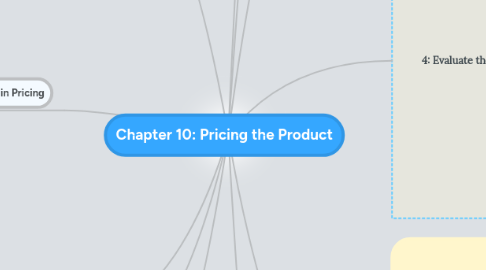
1. Legal and Ethical Considerations in Pricing
1.1. Bait-and-Switch
1.2. Loss Leaders
1.3. Price Fixing
1.3.1. Horizontal Price Fixing
1.3.1.1. Cartel
1.3.2. Vertical Price Fixing
1.3.3. Predatory Pricing
2. Psychological Issues in Pricing
2.1. Buyer's pricing expectations
2.1.1. Internal Reference Prices
2.1.1.1. Reference Pricing Strategies
2.1.1.2. Assimilation Effect
2.1.1.3. Contrast Effect
2.1.2. Price/Quality Inference
2.2. Psychological Pricing Strategies
2.2.1. Odd-Even pricing
2.2.1.1. Odd
2.2.1.2. Even
2.2.2. Price Lining
3. Price
4. Demand
5. Pricing and Electronic Commerce
5.1. Dynamic Pricing Strategies
5.2. Auctions
5.3. Pricing Advantages for Online Shoppers
5.3.1. Search Engines
5.3.2. Detailed Information
5.3.3. Lower's costs through time saving
6. 1: Develop Sales or Market Share Objectives
6.1. Profit Objectives
6.2. Sales or Market Share Objectives
6.3. Competitive Effect Objectives
6.4. Customer Satisfaction Objectives
6.5. Image Enhancement Objectives
6.5.1. Prestige Products
7. 2. Estimate Demand
7.1. Law of Demand
7.1.1. Prestige Products
7.2. Shifts in Demand
7.3. Estimating Demand
7.3.1. Estimates of potential Sales
7.4. Price Elasticity of Demand
7.4.1. E > 1: Elastic Demand
7.4.2. E < 1: Inelastic Demand
7.5. Substitute
7.5.1. Cross-elasticity of Demand
7.6. Complements
8. 3: Determine Costs
8.1. Variable Costs
8.2. Fixed Costs
8.2.1. Average Fixed Costs
8.3. Break-Even Analysis
8.3.1. Contribution per Unit
8.3.2. Target Profit
8.3.2.1. Added to FC
8.3.2.2. Added to VC on a per-unit basis
8.4. Marginal Analysis
8.4.1. Marginal Costs
8.4.2. Marginal Revenue
8.4.3. MC = MR
9. 4: Evaluate the Pricing Environment
9.1. Economy
9.1.1. Recession
9.1.2. Inflation
9.2. Competition
9.2.1. Price Wars
9.2.2. Industry Structures
9.2.2.1. Oligopoly
9.2.2.2. Monopoly
9.2.2.3. Perfect Competition
9.3. Consumer Trends
10. 5: Choose a Price Strategy
10.1. Based on Cost
10.1.1. Cost-Plus pricing
10.2. Based on Demand
10.2.1. Target Costing
10.2.2. Yield Management Pricing
10.3. Based on Competition
10.4. Based on Customer Needs
10.4.1. Value Pricing / Everyday Low Pricing
10.5. New Product Pricing
10.5.1. Skimming Price
10.5.2. Penetration Pricing
10.5.3. Trial Pricing
11. 6: Develop Pricing Tactics
11.1. Pricing for Individual Products
11.1.1. Two-Part Pricing
11.1.2. Payment Pricing
11.2. Pricing for Multiple Products
11.2.1. Price Bundling
11.2.2. Captive Pricing
11.3. Distribution Based Pricing
11.3.1. Free on Board (FOB)
11.3.1.1. FOB origin
11.3.1.2. FOB delivered
11.3.2. Base-point Pricing
11.3.3. Uniform Delivered Pricing
11.3.4. Freight absorption pricing
11.4. Discounting for Channel Members
11.4.1. List Price / Recommended Retail Price
11.4.2. Trade or functional discounts
11.4.3. Quantity Discount
11.4.3.1. Cumulative Quantity Discount
11.4.3.1.1. Rebate
11.4.3.2. Non-cumulative quantity discount
11.4.4. Cash Discount
11.4.5. Seasonal Discount
